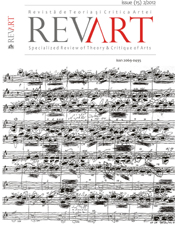TWO SONATAS – A SHARED SONOROUS UNIVERSE: THE IIIRD SONATA OP. 25 BY G. ENESCU AND THE SONATA IN ROMANIAN RHAPSODYC STYLE BY T. CIORTEA. TONAL-MODAL A
TWO SONATAS – A SHARED SONOROUS UNIVERSE: THE IIIRD SONATA OP. 25 BY G. ENESCU AND THE SONATA IN ROMANIAN RHAPSODYC STYLE BY T. CIORTEA. TONAL-MODAL A
Author(s): Petre Marcel VârlanSubject(s): Cultural Essay, Political Essay, Societal Essay
Published by: Editura Eurostampa
Keywords: Enescu; Ciortea; sonata; violin; folklore; tonal-modal
Summary/Abstract: The IIIrd Sonata op. 25 ”in folkloric Romanian character” by G. Enescu (1881- 1955) and The Sonata in Rhapsodic Style by T. Ciortea (1903-1982) capitalize the universe which is familiar to both composers, namely the national folkloric ethos. The study is meant to point out the way in which the two important chamber plays meant for the ensemble violin-piano are similar to each other due to certain elements of musical language, like the tonal-modal aspects. The interest arisen by the relevant similarities is also due to the relatively early moment when, after the Enescian Sonata was released (1926), T. Ciortea composed his sonata (1946, rev. 1974). The study points out the substantiation of modalism within a tonal central principle, the major-minor balance, the employment of the chromatic modal universe, the semitone-tone mode and the involvement of the Enescian cell ”x” when setting up the modal formations. As proven by the present study, the shared tonal-modal vision of the two sonatas show the fact that T. Ciortea had learned the Enescian ”lesson” of employing the folkloric elements in the cultured music, by composing a musical work which can be compared with the famous model, but without being an imitation. In fact, the Transylvanian composer is one of the first great analysts who have investigated the Enescian composition style in a study, which although was published the year when Enescu died, it has been a landmark ever since due to the quality of the musicological appreciations.
Journal: REVART
- Issue Year: 16/2012
- Issue No: 2
- Page Range: 55-61
- Page Count: 7
- Language: English
- Content File-PDF

